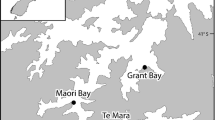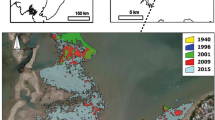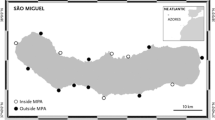Abstract
Degradation and loss of natural habitats due to human activities is a main cause of global biodiversity loss. In temperate systems, seaweeds are a main habitat former and support extremely diverse communities, including many economically important species. Coastal urbanisation is, however, causing significant declines of key habitat-forming seaweeds. To develop successful management strategies such as seaweed habitat restoration, it is necessary to first determine what additional ecosystem values are likely to be added through restoration and to provide baseline data against which goals can be established and success can be measured. The habitat-forming fucoid Phyllospora comosa was once common on shallow subtidal reefs around Sydney, Australia’s largest city, but disappeared in the 1980s, coincident with heavy sewage outfall discharges. To provide the baseline data necessary for restoring and managing Phyllospora in areas from where it has disappeared, we quantified the community composition and abundance of fish and large invertebrates (abalone and sea urchins) in healthy Phyllospora habitats and compared them to those in Ecklonia radiata (the other major habitat-forming kelp in the region) as well as other common shallow subtidal habitats. Fish assemblage structure was similar between Phyllospora vs Ecklonia beds, but Phyllospora supported much greater numbers of abalone and urchins than any other habitat. This suggests that, in terms of some components of the biodiversity it supports, Phyllospora is functionally unique and not a redundant species. Restoring this seaweed will, therefore, also contribute to biodiversity rehabilitation by restoring unique faunal assemblages that are supported by Phyllospora, including economically important species.




Similar content being viewed by others
References
Airoldi L, Beck MW (2007) Loss, status and trends for coastal marine habitats of Europe. Oceanogr Mar Biol Annu Rev 45:345–405
Anderson MJ (2001) A new method for non-parametric multivariate analysis of variance. Austral Ecol 26:32–46
Anderson MJ, Millar RB (2004) Spatial variation and effects of habitat on temperate reef fish assemblages in northeastern New Zealand. J Exp Mar Biol Ecol 305:191–221
Anderson MJ, Gorley RN, Clarke KR (2007) Permanova + for Primer: guide to software and statistical methods. Primer-E, Plymouth
Andrew NL (1991) Changes in subtidal habitat following mass mortality of sea-urchins in Botany Bay, New South Wales. Aust J Ecol 16:353–362
Andrew NL (1999) Under southern seas: the ecology of Australia’s rocky reefs. UNSW Press, Sydney
Andrew NL, Underwood AJ (1989) Patterns of abundance of the sea urchin Centrostephanus rodgersii (Agassiz) on the central coast of New South Wales, Australia
Andrew NL, Underwood AJ (1992) Associations and abundance of sea urchins and abalone on shallow subtidal reefs in southern New South Wales. Aust J Mar Freshwat Res 43:1547–1559
Bishop MJ, Coleman MA, Kelaher BP (2010) Cross-habitat impacts of species decline: response of estuarine sediment communities to changing detrital resources. Oecologia 163:517–525
Bruno JF, Bertness MD (2001) Habitat modification and facilitation in benthic marine communities. In: Bertness MD, Gaines SD, Hay ME (eds) Marine community ecology. Sinauer, Sunderland, pp 201–220
Choat JH, Ayling AM (1987) The relationship between habitat structure and fish faunas on New Zealand reefs. J Exp Mar Biol Ecol 110:257–284
Chung IK, Beardall J, Mehta S, Sahoo D, Stojkovic S (2011) Using marine macrolagae for carbon sequestration: a critical appraisal. J Appl Phycol 23:877–886
Clarke KR, Gorley RN (2006) PRIMER v6: user manual/tutorial. PRIMER-E, Plymouth
Coleman MA, Kelaher BP, Steinberg PD, Millar AJK (2008) Absence of a large brown macroalga on urbanized rocky reefs around Sydney, Australia, and evidence for historical decline. J Phycol 44:897–901
Connell SD (2007) Water quality and the loss of coral reefs and kelp forests: alternative states and the influence of fishing. In: Connell SD, Gillanders BM (eds) Marine ecology. Oxford University Press, Melbourne, pp 556–568
Connell SD, Russell BD, Turner DJ, Shepherd SA, Kildea T, Miller D, Airoldi L, Cheshire A (2008) Recovering a lost baseline: missing kelp forests from a metropolitan coast. Mar Ecol Prog Ser 360:63–72
Curley BG, Kingsford MJ, Gillanders BM (2002) Spatial and habitat-related patterns of temperate reef fish assemblages: implications for the design of marine protected areas. Mar Freshwat Res 53:1197–1210
Day E, Branch GM (2002) Effects of sea urchins (Parechinus angulosus) on recruits and juveniles of abalone (Haliotis midae). Ecol Monogr 72:133–149
Dayton PK (1985) Ecology of kelp communities. Annu Rev Ecol Syst 16:215–245
Fleming AE (1995) Growth, intake, feed conversion efficiency and chemosensory preference of the Australian abalone Haliotis rubra. Aquaculture 132:297–311
Froese R, Pauly D (2005) Fishbase. World Wide Web electronic publication. http://www.fishbase.org
Goodsell PJ, Chapman MG (2009) Rehabilitation of habitat and the value of artificial reefs. In: Wahl M (ed) Marine hard bottom communities: patterns, dynamics, diversity, and change. Springer, New York, pp 333–344
Goodsell PJ, Connell SD (2005) Historical configuration of habitat influences the effects of disturbance on mobile invertebrates. Mar Ecol Prog Ser 299:79–87
Harman N, Harvey ES, Kendrick GA (2003) Differences in fish assemblages from different reef habitats at Hamelin Bay, south-western Australia. Mar Freshwat Res 54:177–184
Holbrook SJ, Kingsford MJ, Schmitt RJ, Stephens JS (1994) Spatial and temporal patterns in assemblages of temperate reef fish. Am Zool 34:463–475
Huggett MJ, de Nys R, Williamson JE, Heasman M, Steinberg PD (2005) Settlement of larval blacklip abalone, Haliotis rubra, in response to green and red macroalgae. Mar Biol 147:1155–1163
Kennelly SJ, Underwood AJ (1993) Geographic consistencies of effects of experimental physical disturbance on understorey species in sublittoral kelp forests in central New South Wales. J Exp Mar Biol Ecol 168:35–58
Kojima H (1981) Mortality of young Japanese black abalone Haliotis discus discus after transplantation. Bull Jap Soc Sci Fish 47:151–159
Lotze HK, Coll M, Magera AM, Ward-Paige C, Airoldi L (2011) Recovery of marine animal populations and ecosystems. Trends Ecol Evol 26:595–605
Mann KH (1973) Seaweeds: their productivity and strategy for growth. Science 182:975–981
Mann KH (2000) Ecology of coastal waters. Blackwell, Malden
Mayfield S, Branch GM (2000) Interrelations among rock lobsters, sea urchins, and juvenile abalone: implications for community management. Can J Fish Aquat Sci 57:2175–2185
Mayfield S, Mundy C, Gorfine H, Hart AM, Worthington D (2012) Fifty years of sustained production from the Australian abalone fisheries. Rev Fish Sci 20:220–250
Poloczanska ES, Babcock RC, Butler A, Hobday A, Hoegh-Guldberg O, Kunz TJ, Matear R, Milton DA, Okey TA, Richardson AJ (2007) Climate change and Australian marine life. In: Gibson RN, Atkinson RJA, Gordon JDM (eds) Oceanography and marine biology, vol 45. CRC Press, New York, pp 407–478
Roberts R (2001) A review of settlement cues for larval abalone (Haliotis spp.). J Shellfish Res 20:571–586
Rogers-Bennett L, Pearse JS (2001) Indirect benefits of marine protected areas for juvenile abalone. Conserv Biol 15:642–647
Saunders TM, Connell SD, Mayfield S (2009) Differences in abalone growth and morphology between locations with high and low food availability: morphologically fixed or plastic traits? Mar Biol 156:1255–1263
Scanes PR, Philip N (1995) Environmental impact of deepwater discharge of sewage off Sydney, NSW, Australia. Mar Pollut Bull 31:343–346
Shepherd SA (1973) Studies on southern Australian abalone (genus Haliotis).1. Ecology of 5 sympatric species. Aust J Mar Freshwat Res 24:217–257
Smith SV (1981) Marine macrophytes as a global carbon sink. Science 211:838–840
Steinberg PD, van Altena I (1992) Tolerance of marine invertebrate herbivores to brown algal phlorotannins in temperate Australasia. Ecol Monogr 62:189–222. doi:10.2307/2937093
Steneck RS, Graham MH, Bourque BJ, Corbett D, Erlandson JM, Estes JA, Tegner MJ (2002) Kelp forest ecosystems: biodiversity, stability, resilience and future. Environ Conserv 29:436–459
Sydney Water (2007) Sydney’s deepwater ocean outfalls: long-term environmental performance. Sydney Water, Sydney
Tarr RJQ, Williams PVG, Mackenzie AJ (1996) Abalone, sea urchins and rock lobster: a possible ecological shift that may affect traditional fisheries. S Afr J Mar Sci 17:319–323
Underwood AJ (1997) Experiments in ecology. Their logical design and interpretation using analysis of variance. Cambridge University Press, Cambridge
Underwood AJ, Chapman MG (1997) GMAV 5 for Windows. University of Sydney, Sydney
Underwood AJ, Kingsford MJ, Andrew NL (1991) Patterns in shallow subtidal marine assemblages along the coast of New South Wales. Aust J Ecol 16:231–249
Wernberg T, Russell BD, Moore PJ, Ling SD, Smale DA, Campbell A, Coleman MA, Steinberg PD, Kendrick GA, Connell SD (2011) Impacts of climate change in a global hotspot for temperate marine biodiversity and ocean warming. J Exp Mar Biol Ecol 400:7–16
Winer BJ, Brown DR, Michels KM (1991) Statistical principles in experimental design. McGraw-Hill, New York
Young TP, Petersen DA, Clary JJ (2005) The ecology of restoration: historical links, emerging issues and unexplored realms. Ecol Lett 8:662–673
Acknowledgments
This work was funded by a Discovery Grant (DP1096464) from the Australian Research Council (awarded to PDS and MAC), an Early Career Researcher grant to AV, EMM and AHC, an Evolution and Ecology Research seed Grant to EMM, AHC and AV (both from UNSW) and the Centre for Marine Bio-Innovation (CMB). This is contribution # 112 from the Sydney Institute of Marine Sciences.
Author information
Authors and Affiliations
Corresponding author
Additional information
E. M. Marzinelli and A. H. Campbell equally contributed to this article.
Rights and permissions
About this article
Cite this article
Marzinelli, E.M., Campbell, A.H., Vergés, A. et al. Restoring seaweeds: does the declining fucoid Phyllospora comosa support different biodiversity than other habitats?. J Appl Phycol 26, 1089–1096 (2014). https://doi.org/10.1007/s10811-013-0158-5
Received:
Revised:
Accepted:
Published:
Issue Date:
DOI: https://doi.org/10.1007/s10811-013-0158-5




